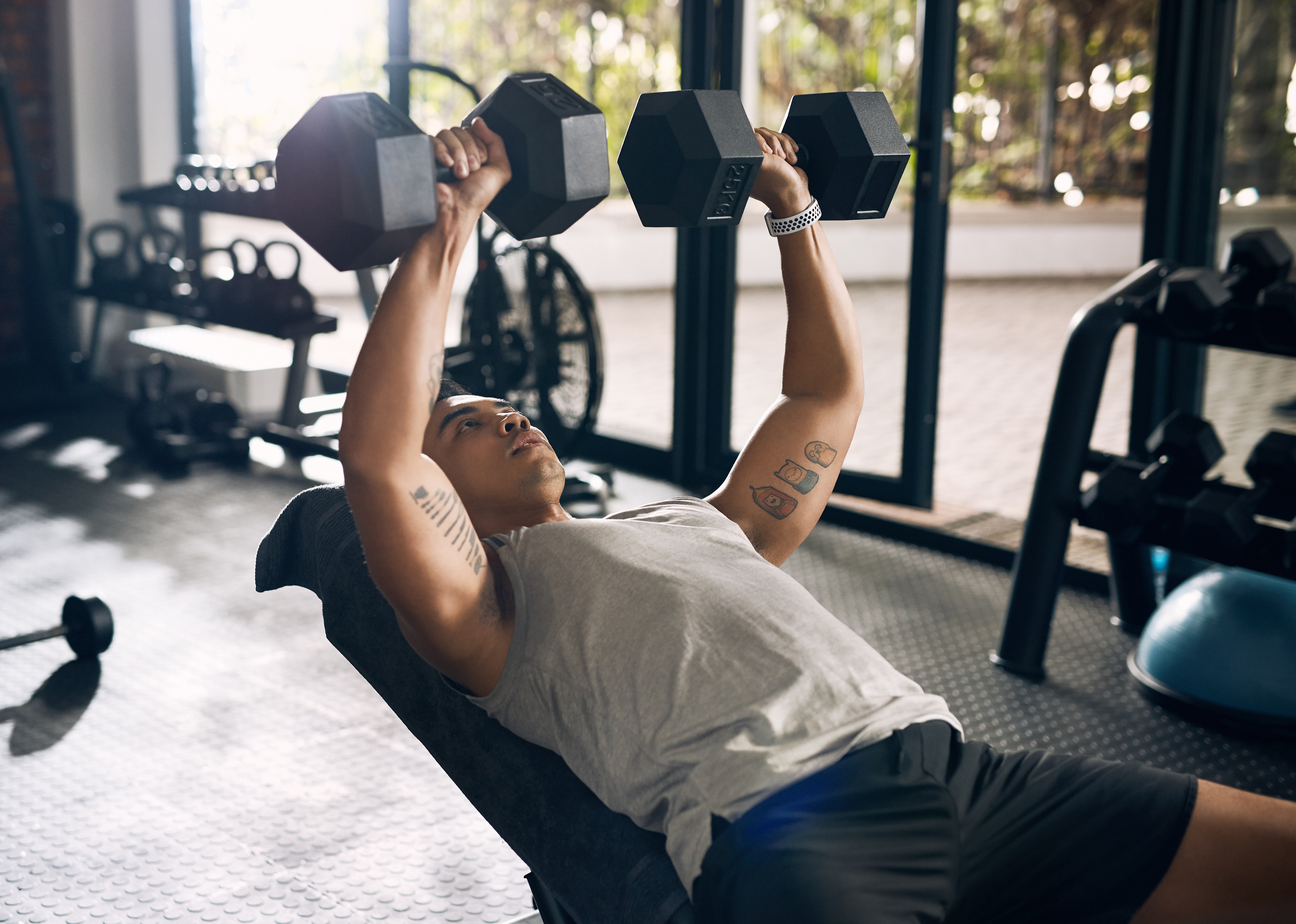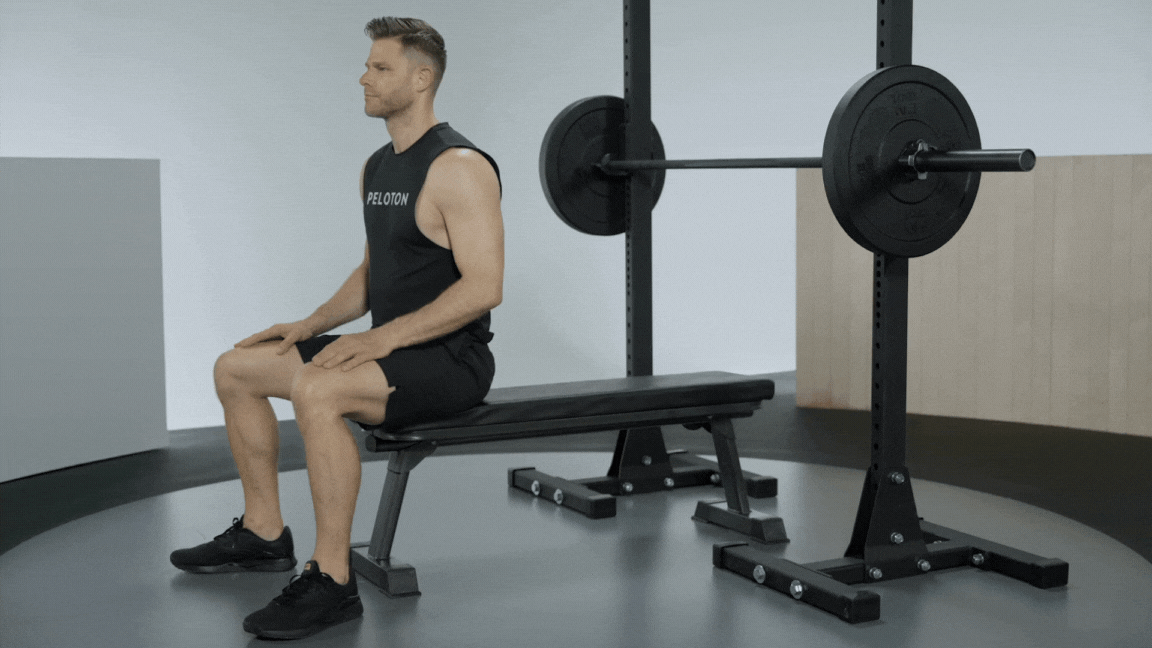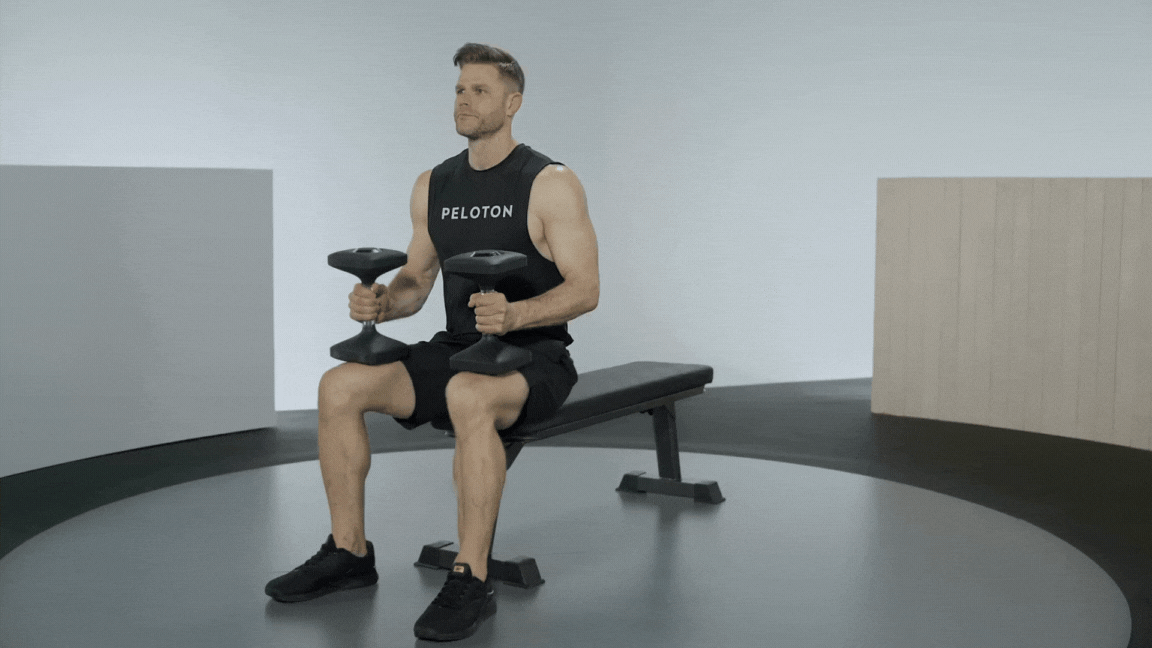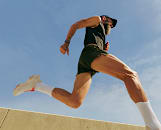
Hiraman via Getty Images
How to Build Chest Muscles (with More Than Just Push-Ups)
Here's exactly how to optimize your training for maximum chest gains.
By Andrew Gutman•
The Benefits of Building Bigger, Stronger Chest Muscles
How to Build Chest Muscles with Strength Training
Top Chest-Building Exercises to Try
The Rest of the Chest Gains Equation
The Takeaway
The pectoral muscles (i.e., chest muscles, often called “pecs”) aren’t just vanity muscles; they’re primary movers that help you push open doors, power your workouts, and work with your back to prevent your posture from collapsing. And if you are physique-minded, a larger chest will broaden your silhouette.
Discover more ways to reach your goals with Peloton
Unsure how to build chest muscles? We asked Peloton instructor Cliff Dwenger and Brian Sutton, who oversees the development of certification and continuing education courses at the National Academy of Sports Medicine (NASM), to explain how to get chest muscles, which exercises to prioritize, and how to fuel the kind of gains that last.
The Benefits of Building Bigger, Stronger Chest Muscles
Increased Functional Strength: You don’t need a 225-pound bench press to carry groceries or load a suitcase into the overhead bin, but training for a stronger chest and upper body will help you build functional strength that helps you perform everyday tasks more easily.
Improved Aging: Maintaining muscle and preserving bone density—two benefits rewarded by consistent strength training—are key to moving with confidence as you age. One study showed that progressive resistance training increased bone mineral density, particularly in the hips and femur, by up to 3 percent, while also enhancing muscular performance. Stronger bones and muscles reduce injury risk, improve balance, and can help you continue to move well as you age.
Balanced Posture: The muscles in your back pull your shoulders back, working in synergy with your chest muscles to keep you upright. That said, you should train your pecs in balance with your back. Do full-range-of-motion presses and flys, pairing them with rows and rear delt work, to facilitate improved posture.
Visibly Bigger Muscles: Health and aesthetics aren’t mutually exclusive; not everyone cares about building muscle for appearance’s sake. But for those who do, training your chest consistently will broaden your torso and increase the visible size of your pecs.

Peloton App
Access thousands of classes with no equipment needed.
How to Build Chest Muscles with Strength Training
To build your chest, you need to train consistently and with intention. That means choosing the right exercises, adjusting your sets and reps over time, and being patient. As for how long it takes to build muscle, experts say you can expect to see noticeable changes in about 4 to 12 weeks. So if you stick with it, the results will come.
Optimize Reps, Sets, and Rest for Hypertrophy
Training volume—your sets multiplied by reps multiplied by weight—is a significant driver of muscle growth. You don’t need a calculator in your gym bag. You do, however, need to understand how acute variables like sets, reps, rest, and intensity feed into your total volume.
Sets: For hypertrophy, the International Universities Strength and Conditioning Association (IUSCA) recommends a minimum of 10 weekly sets per muscle group to spark growth for beginners and 12 to 20 weekly sets for more experienced lifters. Sutton says beginners can perform 1–3 sets of 2–3 chest exercises per workout, 2–4 times per week. After about a month of consistent training, do 3–5 sets of chest exercises per workout, 3–6 days per week.
Reps: “Building muscle happens in the hypertrophy range of 8–12 reps, sometimes even 6–12,” Cliff says. That rep range is also recommended by the National Academy of Sports Medicine (NASM). Moderate rep counts allow you to lift weights heavy enough to create real tension without the burnout associated with high-rep sets. They’re also easier to progress: it’s simpler to track effort and add weight for eight reps than 25.
Rest: Your body needs rest between sets to restore its short-term energy stores. The IUSCA recommends resting at least two minutes between sets for compound exercises (aka multi-joint movements that require more energy). If you’re performing isolation movements like biceps curls or lateral raises, rest for 30 seconds to a minute and a half between sets. You want to ensure you’re giving your muscles 48 to 72 hours to recover before working them again in the gym. Your muscles grow between workouts, not during them, and this rest is imperative to that process.
Intensity: Intensity refers to the amount of weight you’re lifting relative to your one-rep max, but most people don’t know that number. Instead, use the reps in reserve (RIR) method: finish your sets with no more than two reps left in the tank. The last reps should feel tough, but you should still be able to finish your sets with good form.
Train Chest 2-4 Times Per Week
Overall training volume matters most for chest growth, but so does frequency. A 2016 meta-analysis published in Sports Medicine found that splitting volume across two sessions per week led to better muscle gains than a single session, even when the total number of sets performed was equal.
Why? Cramming all your chest work into one day often leads to fatigue midway through, and by sets eight through 12, you’re just going through the motions. These “junk sets” look productive but do little for growth.
A smarter approach is to follow a workout split that hits multiple muscle groups per session, like an upper-lower split or full-body routine. By training your upper and lower body each twice per week, for example, you can knock out five quality chest sets per upper-body workout instead of five strong sets followed by five sluggish ones. It also improves recovery. Longer chest days often leave you too sore to train effectively later in the week.
How often you train a specific muscle will depend on your split. If you follow the upper-lower split referenced above, you’ll train every muscle twice per week. If you follow a full-body split, then you can hit your muscles even more frequently—up to four times per week, according to Sutton.
Progress Your Lifts
“To build muscle, you need to challenge your muscles progressively by increasing the intensity of your workouts over time,” explains Sutton. “This can be done by increasing the [amount of] weight you lift, the number of repetitions and/or sets, and the frequency of your workouts.”
This principle is known as progressive overload, and it’s a vital principle of long-term muscle growth. In practice, it means steadily increasing the amount of work you’re doing in the gym. You don’t need to max out every session, but you need to do more—reps, weight, total volume—over time.
Hit Your Pecs from Every Angle
“You also want to hit your chest from different angles to target every section—flat bench for overall mass, incline for upper chest, decline for lower,” says Cliff.
The chest consists of fibers that run in slightly different directions, often referred to as the upper and lower regions. Research shows that the incline bench press, for example, activates more fibers in the upper chest compared to the lower.
“While there is some legitimacy to the idea of training the chest from different angles to develop the muscle fully…the chest is a single muscle group and cannot be completely isolated into specific regions,” Sutton adds. “That said, incorporating exercises that target different areas of the chest can provide a more comprehensive and balanced chest workout.”
You don’t need to stress about hitting every angle to grow your chest, but it helps if you want a well-rounded look. To do that, mix up your movements. On one day, pair a low-incline dumbbell press with flat dumbbell flyes. Later in the week, go with standing cable flys and hand-elevated push-ups.
Top Chest-Building Exercises to Try
Below are Cliff’s top three favorite chest exercises, along with step-by-step instructions on how to perform them and variations to mix into your workouts.

1. Barbell Bench Press
“[The bench press] is great for overall chest size and strength,” says Cliff. “You can load it relatively heavy, and it targets the middle part of your chest.” Keep your workouts fresh by subbing in variations like the incline barbell bench press, which targets the upper chest and shoulders more, or the Smith machine bench press, which provides more stability and allows you to push closer to failure. (If you’re new to bench pressing barbells or you’re challenging yourself with a heavy weight, it’s a good idea to ask someone to spot you during this move.)
Lie flat on a bench with your eyes under a barbell.
Plant your feet into the ground, arch your back slightly, and grip the bar with your hands just wider than shoulder-width distance apart.
Unrack the barbell, and lower it with control to your sternum, bending your elbows so your upper arms point away from your torso at about a 45-degree angle. Pause for one second while keeping tension on your chest muscles.
Press the weight back up to return to the starting position.

2. Dumbbell Chest Press
Cliff specifically likes the unilateral aspect of the dumbbell press, meaning each side of your body works independently to lift the dumbbells. “They’re great for hitting each side of your chest evenly,” he says. “As both arms move independently, you’re working stabilizer muscles, which can help improve your technique and increase the weight you lift on the barbell bench press.” Doing decline, incline, and even single-arm dumbbell presses can provide variation to your routine.
Sit upright on a flat workout bench with a dumbbell in each hand resting on your thighs.
Begin to lie back toward the bench, simultaneously raising one knee at a time to kick each dumbbell toward your chest. Allow the dumbbells to settle into position next to your chest, elbows bent so your upper arms point away from your torso at about a 45-degree angle, and are just below parallel to the floor. Squeeze your shoulder blades together and slightly arch your lower back. This is your starting position.
Press the weights up until your arms are straight and the dumbbells are directly over your chest.
Slowly lower the weights to return to the starting position.
3. Cable Chest Fly
“A great benefit of cable exercises is that cables keep tension on the muscle throughout the whole movement,” Cliff explains. “The aim is to get a deep stretch in the eccentric phase. It’s perfect for chest definition.” As a variation, try the seated chest fly, which allows you to move more weight and achieve a deeper pec stretch, as your back is anchored against a seat pad.
Set the cable machine pulleys a couple of notches above your shoulders. Attach a D-handle to each pulley and hold one in each of your hands.
Take a couple of large steps forward until there’s tension in the cables, extending your arms out to the sides. Stagger your stance (one foot in front of the other) to stabilize your body, and bend your elbows slightly to reduce pressure on your elbow joint.
Draw your arms together to initiate the fly, stopping when your hands are about an inch or two from touching in front of your chest.
Reverse the movement, opening your arms to return to the starting position, allowing your arms come back as far as possible without any discomfort. Hold this position for a couple of seconds before beginning the next rep.
The Rest of the Chest Gains Equation
How you train your chest is crucial for progress, but so are out-of-the-gym factors like recovery and diet.
Nutrition
If you want to increase muscle growth and grow your chest, you have to eat enough to fuel that growth. For consistent gains, aim for a modest daily calorie surplus, with an emphasis on protein.
“Protein is essential for muscle growth and repair,” Sutton adds. “Aim to consume adequate protein from healthy sources like lean meats, poultry, fish, eggs, low-fat dairy, legumes, and (if needed) protein supplements.” To build muscle, dietitians recommend aiming for 1.4–2.2 grams of protein per kilogram of body weight each day.
Sleep
Poor sleep has been shown to decrease muscle tissue. One study even showed that a single night of inadequate sleep can reduce protein synthesis—the body’s process of building protein cells—by 18 percent.
Ideally, you want to sleep between seven and nine hours each night. Ensure your sleep hygiene is in check by sticking to a consistent sleep schedule, establishing a wind-down routine (such as meditation, reading a book, or taking a bath), keeping your room cool, dark, and quiet, and avoiding electronics, caffeine, and alcohol close to bedtime.
The Takeaway
Whether you’re chasing a bigger bench or want to build your chest muscles for aesthetic reasons, these are the rules to keep your chest workouts on point:
Train your chest at least twice per week to maximize volume and work efficiently.
Stick to 6-20 weekly sets based on your training experience.
Do 6-12 reps per set to build muscle while balancing load and recovery.
Use progressive overload: Add reps until you hit the top of your range, then increase the weight.
Hit your chest from multiple angles (flat, incline, cables) for more complete development.
Eat in a slight calorie surplus and hit your protein targets.
Get 7-9 hours of sleep each night.
This content is for informational and educational purposes only and does not constitute individualized advice. It is not intended to replace professional medical evaluation, diagnosis, or treatment. Seek the advice of your physician for questions you may have regarding your health or a medical condition. If you are having a medical emergency, call your physician or 911 immediately.
Build full-body strength
Enter your email to get articles, instructor tips, and updates from Peloton sent to your inbox.
By providing your email address, you agree to receive marketing communications from Peloton.
For more about how we use your information, see our Privacy Policy.













